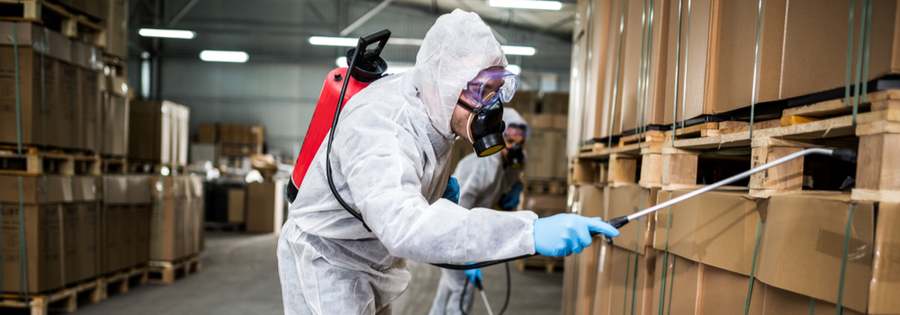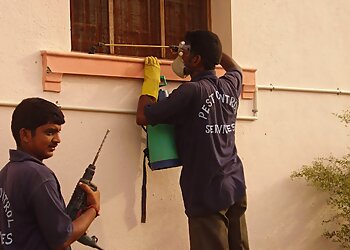A Comprehensive Guide to the Different Types of Bug Control Approaches
With the myriad of bug control techniques available, it can be overwhelming to find the most reliable solution for a particular pest problem. In this comprehensive overview, we will discover these various kinds of bug control methods, supplying insights right into their applications and benefits. By the end, you will certainly have a clearer understanding of which technique might be the best fit for your parasite control needs.
Chemical Bug Control Methods

One typical kind of chemical pest control is insecticides. Pesticides are chemical substances that are especially developed to eliminate or ward off insects. They can be used in different types, such as sprays, baits, or dusts. Insecticides target specific pests, such as insects, termites, or ants, and can be made use of both inside and outdoors.
One more type of chemical parasite control is rodenticides. These are chemical materials created to manage populations of rats, such as rats and mice.
Herbicide, additionally recognized as herbicides, are an additional sort of chemical bug control method. Herbicides are developed to selectively kill unwanted plants, known as weeds, without creating injury to desirable plants. They are generally made use of in farming, landscape design, and gardening to control the growth of unwanted vegetation.
While chemical parasite control techniques can be highly effective in eliminating bugs, it is necessary to use them sensibly and comply with security guidelines. Overuse or misuse of chemical pesticides can have adverse effect on human health and wellness and the environment. Therefore, it is essential to use these techniques sensibly and think about alternative parasite control methods whenever possible.
Biological Parasite Control Approaches
Biological bug control approaches involve the use of living organisms or all-natural materials to take care of and control pest populations. Unlike chemical methods, which usually count on synthetic pesticides, biological control techniques make use of the natural opponents of bugs to regulate their populations. This technique is considered more eco-friendly and sustainable, as it decreases the use of dangerous chemicals and decreases the threat of pesticide resistance.
One commonly made use of organic pest control method is the intro of all-natural predators or bloodsuckers. For instance, ladybugs are introduced to manage aphids, while particular wasp varieties are released to target caterpillars. These killers and parasites eat parasites, lowering their numbers and stopping infestations.
One more organic control technique is making use of pathogens. Specific bacteria, viruses, and fungi can be used to infect and eliminate specific parasites. For instance, the germs Bacillus thuringiensis is generally made use of to regulate caterpillars, as it produces toxic substances that are dangerous to these parasites.
Organic control methods can additionally include using scents or all-natural materials that interfere with the mating patterns of pests. By hindering their reproduction, these techniques assist to decrease pest populaces in time.
While organic pest control methods are usually reliable, they might require longer periods to achieve desired results contrasted to chemical methods. Furthermore, mindful consideration must be given to the option and release of all-natural enemies to stop unintentional injury to useful microorganisms or environments.
Physical Pest Control Techniques
To successfully take care of and control pest populaces, different insect control techniques called physical insect control techniques are used. These methods include the usage of physical obstacles, traps, or gadgets to protect against insects from accessing or harming building. One common physical bug control technique is using screens or internet to maintain bugs out of structures or gardens. These displays are typically made from great you could look here mesh material that enables ventilation while stopping pests from going into. Another physical bug control approach is the setup of fencings or wall surfaces to maintain bigger insects, such as deer or bunnies, out of gardens or farming fields. These obstacles physically obstruct the pests' access to the area, minimizing the possibility for damages. Additionally, catches and tools can be used to catch or drive away insects. As an example, sticky catches can be put in locations where pests are a trouble, and the pests become stayed with the sticky surface area. Ultrasonic devices can also be utilized to send out high-frequency sounds that are unpleasant to insects, causing them to leave the area. Physical insect control methods are an environmentally friendly choice to chemical pesticides, as they do not depend on using dangerous chemicals.
All-natural Insect Control Approaches
Natural parasite control techniques offer a sustainable and environment-friendly technique to managing and eliminating bugs. These methods focus on the use of natural materials and organic agents, reducing the demand for chemical pesticides that can hurt the environment and human wellness. One of the most typical natural parasite control methods is organic control. This entails presenting all-natural predators or bloodsuckers to victimize or parasitize the insects. Ladybugs are often presented to gardens to control aphid populations. Another natural method is using repellents originated from plants. Certain plants, such as marigolds, lavender, and pepper mint, send out aromas that fend off bugs like insects, flies, and ants. Additionally, cultural control methods can Continued be used to avoid and manage bug problems. This includes appropriate cleanliness, normal maintenance, and promoting biodiversity in the garden. For instance, turning plants, removing yard debris, and motivating all-natural predators can help stop the accumulation of parasites. By embracing these all-natural bug control techniques, individuals and neighborhoods can successfully handle insects while minimizing the adverse effect on the setting and human wellness.
Integrated Parasite Management (IPM)
Integrated Pest Management (IPM) is a thorough and organized approach to pest control that integrates various methods and techniques to properly handle bugs while reducing using chemical pesticides. IPM intends to preserve parasite populations listed below the economic injury degree by utilizing a mix of social, biological, and chemical control approaches.
Social control methods include modifying the setting to make it less favorable for parasites. This can include techniques such as crop rotation, correct sanitation, and using immune plant selections. By producing negative conditions for parasites, cultural control techniques can substantially decrease parasite populaces.

Chemical control techniques are used as a last option in IPM. They entail the targeted and sensible use of chemicals to handle parasite populations. Unlike conventional bug control approaches, IPM aims to minimize making use of chemical pesticides by using alternative techniques.
Integrated Bug Management (IPM) is a positive strategy that concentrates on lasting parasite monitoring instead than relying solely on reactive procedures. By integrating multiple control methods, IPM gives a much more sustainable and eco-friendly method to pest control.
Conclusion
It went over check my reference chemical, organic, physical, and natural pest control techniques, as well as the integrated parasite management method. By recognizing these different techniques, individuals can make informed decisions on which insect control method is most appropriate for their certain needs and choices.